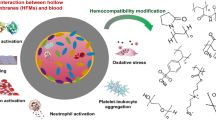Abstract
To characterize the effect of oxidative stress (OS) on the ability of erythrocytes to pass through microvessels and capillaries, we studied the dynamics of the movement of human erythrocytes in vitro, in the channels of a microfluidic device, under the action of an OS inducer, tert-butyl hydroperoxide (tBH), and compared it with a cytological assessment of the transformation of cell membranes. OS induced the impairment of the control over the shape and volume of cells, the decrease in passage speed, and the occlusions of microchannels. The developed microfluidic device provided an assessment of the microreology of erythrocytes under the action of hydroperoxide. In the future, it is possible to use microfluidic analysis of erythrocytes in patients to assess the effect of xenobiotics on microrheology.




Similar content being viewed by others
REFERENCES
R. Huisjes. , A. Bogdanova, W. van Solinge, R. M. Schiffelers, L. Kaestner, and R. van Wijk, Front. Physiol. 9, 656 (2018). https://doi.org/10.3389/fphys.2018.00656
N. Mohandas and P. G. Gallagher, Blood 112, 3939 (2008).
S. Svetina, Cell. Mol. Biol. Lett. 17, 171 (2012). https://doi.org/10.2478/s11658-012-0001-z
T. Franco, H. Chu, and P. S. Low, Biochem. J. 473, 3147 (2016). https://doi.org/10.1042/BCJ20160328
Y. Takakuwa, Curr. Opin. Hematol. 8 (2), 80 (2001).
N. Arashiki, N. Kimata, S. Manno, N. Mohandas, and Y. Takakuwa, Biochemistry 52, 5760 (2013). https://doi.org/10.1021/bi400405p
I. V. Pivkin, Zh. Peng, G. E. Karniadakis, P. A. Buffet, M. Dao, and Subra Suresh, Proc. Natl. Acad. Sci. U.S.A. 113, 7804 (2016). https://doi.org/10.1073/pnas.1606751113
G. Tomaiuolo, Biomicrofluidics 8, 051501 (2014). https://doi.org/10.1063/1.4895755
S. Losserand, G. Coupier, and T. Podgorski, Microvasc. Res. 124, 30 (2019). https://doi.org/10.1016/j.mvr.2019.02.003
G. Barshtein, R. Ben-Ami, and S. Yedgar, Expert Rev. Cardiovasc. Ther. 5, 743 (2007).
E. Nagababu, J. G. Mohanty, J. S. Friedman, and J. M. Rifkind, Free Radical Res. 47, 164 (2013). https://doi.org/10.3109/10715762.2012.756138
I. V. Mindukshev, Yu. S. Sudnitsyna, E. A. Skverchinskaya, A. Yu. Andreeva, I. A. Dobrylko, E. Yu. Senchenkova, A. I. Krivchenko, and S. P. Gambaryan, Biochem. (Moscow) Suppl. Ser. A 13, 352 (2019). https://doi.org/10.1134/S1990747819040081
A. V. Domanski, E. A. Lapshina, and I. B. Zavodnik, Biochemistry (Moscow) 70, 761 (2005). https://doi.org/10.1007/s10541-005-0181-5
L. V. Boas, V. Faustino, R. Lima, J. M. Miranda, G. Minas, C. Fernandes, and S. O. Catarino, Micromachines (Basel) 9, 384 (2018). https://doi.org/10.3390/mi9080384
H. W. Hou, A. A. Bhagat, A. G. Chong, P. Mao, K. S. Tan, J. Han, and C. T. Lim, Lab Chip 10, 2605 (2010). https://doi.org/10.1039/C003873C
J. C. Cluitmans, V. Chokkalingam, A. M. Janssen, R. Brock, W. T. S. Huck, and G. J. C. G. Bosman, BioMed. Res. Int. 2014, 764268 (2014). https://doi.org/10.1155/2014/764268
W. Chien, Z. Zhang, G. Gompper, and D. A. Fedosov, Biomicrofluidics 13, 044106 (2019). https://doi.org/10.1063/1.5112033.eCollection
A. S. Bukatin, I. S. Mukhin, E. I. Malyshev, I. V. Kukhtevich, A. A. Evstrapov, and M. V. Dubina, Tech. Phys. 61 (10), 1566 (2016). https://doi.org/10.1134/S106378421610008X
Chia-Hung Dylan Tsai, Shinya Sakuma, Fumihito Arai, Tatsunori Taniguchi, Tomohito Ohtani, Yasushi Sakatac, and Makoto Kanekoa, RSC Adv. 4, 45050 (2014). https://doi.org/10.1039/C4RA08276A
I. Gurov, M. Volkov, N. Margaryants, A. Pimenov, and A. Potemkin, Opt. Lasers Eng. 104, 244 (2018). https://doi.org/10.1016/j.optlasering.2017.09.003
S. Huang, H. W. Hou, T. Kanias, J. T. Sertorio, H. Chen, D. Sinchar, M. T. Gladwin, and J. Han, Lab Chip 15, 448 (2015).
J. H. Jeong, Y. Sugii, M. Minamiyama, and K. Okamoto, Microvasc. Res. 71, 212 (2006).
E. Pretorius and D. B. Kell, Integr. Biol. 6, 486 (2014). https://doi.org/10.1039/c4ib00025k
E. M. Welbourn, M. T. Wilson, A. Yusof, M. V. Metodiev, and C. E. Cooper, Free Radical Biol. Med. 103, 95 (2017). https://doi.org/10.1016/j.freeradbiomed.2016.12.024
H. Chu, M. M. McKenna, N. A. Krump, S. Zheng, L. Mendelsohn, S. L. Thein, L. J. Garrett, D. M. Bodine, and P. S. Low, Blood 128, 2708 (2016). https://doi.org/10.1182/blood-2016-01-692079
J. M. Kwan, Q. Guo, D. L. Kyluik-Price, H. Ma, and M. D. Scott, Am. J. Hematol. 88, 682 (2013). https://doi.org/10.1002/ajh.23476
A. Sinha, T. T. T. Chu, M. Dao, and R. Chandramohanadas, Sci. Rep. 5, 9768 (2015). https://doi.org/10.1038/srep09768
Funding
This work was supported by the Russian Foundation for Basic Research, project no. 20-34-70111 “Stability.”
Author information
Authors and Affiliations
Corresponding author
Ethics declarations
COMPLIANCE WITH ETHICAL STANDARDS
All procedures performed in a study of human beings comply with ethical standards. Blood samples were obtained from healthy volunteers after obtaining written consent. The study followed the principles of the Helsinki Declaration (according to the 64th WMA General Assembly, Brazil, 2013) and was approved by the Ethics Committee of the Institute of Evolutionary Physiology and Biochemistry, Russian Academy of Sciences (protocol no. 15 of November 21, 2017).
CONFLICT OF INTEREST
The authors declare that they have no conflicts of interest.
Additional information
Translated by I. Shipounova
Rights and permissions
About this article
Cite this article
Skverchinskaya, E.A., Tapinova, O.D., Filatov, N.A. et al. Investigation of Erythrocyte Transport through Microchannels After the Induction of Oxidative Stress with Tert-Butyl Peroxide. Tech. Phys. 65, 1491–1496 (2020). https://doi.org/10.1134/S1063784220090236
Received:
Revised:
Accepted:
Published:
Issue Date:
DOI: https://doi.org/10.1134/S1063784220090236




